In the modern world, Information Technology (IT) security has become a primary concern for individuals and organizations across the globe. As technology advances, so do the techniques used by cybercriminals, leading to an increase in the frequency and severity of cyberattacks. A single security breach can result in significant data loss, reputation damage, and financial repercussions.
IT security is crucial for safeguarding digital assets, whether it's personal data, intellectual property, or confidential business information. As we move into 2025, the landscape of cybersecurity continues to evolve. This comprehensive guide aims to break down the most pressing IT security risks businesses and individuals face, the best solutions to address them, and practical steps to protect data in the digital age.
What is Information Technology Security?
Information Technology (IT) Security refers to the practices, tools, and policies implemented to protect computers, networks, and data from cyber threats. These threats can range from data breaches and malware to hacking and denial-of-service attacks.
IT security is composed of various subfields, including:
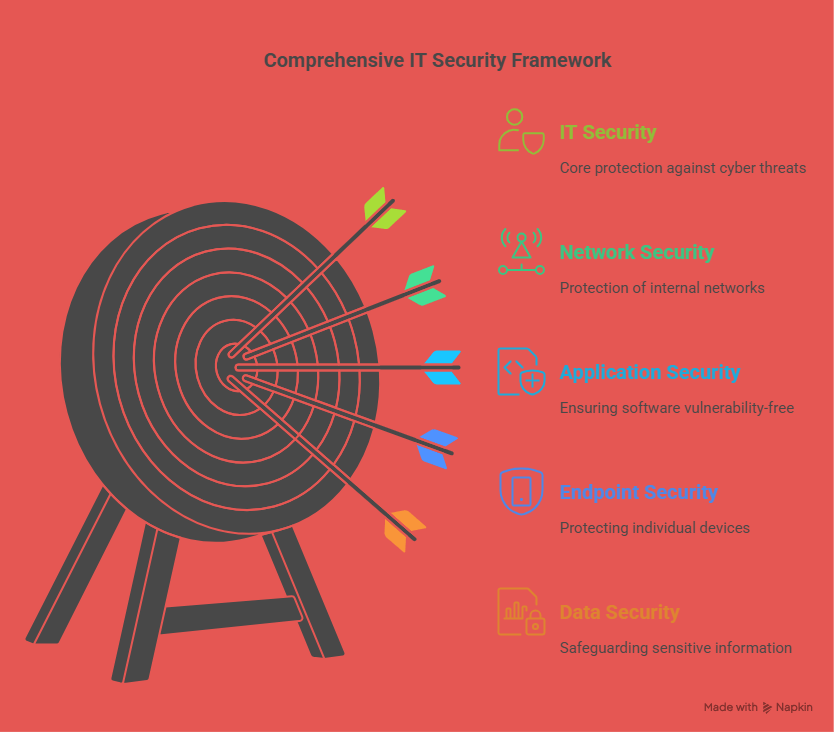
-
Network Security: The protection of internal networks from unauthorized access or misuse.
-
Application Security: Ensuring that software applications are free from vulnerabilities that could be exploited by attackers.
-
Endpoint Security: Protecting individual devices such as smartphones, laptops, and desktops.
-
Data Security: Safeguarding sensitive information to prevent unauthorized access or alteration.
-
Cloud Security: Securing data stored in cloud environments to protect against data loss or breaches.
This multi-layered approach ensures comprehensive protection across all digital platforms.
Major IT Security Risks in 2025
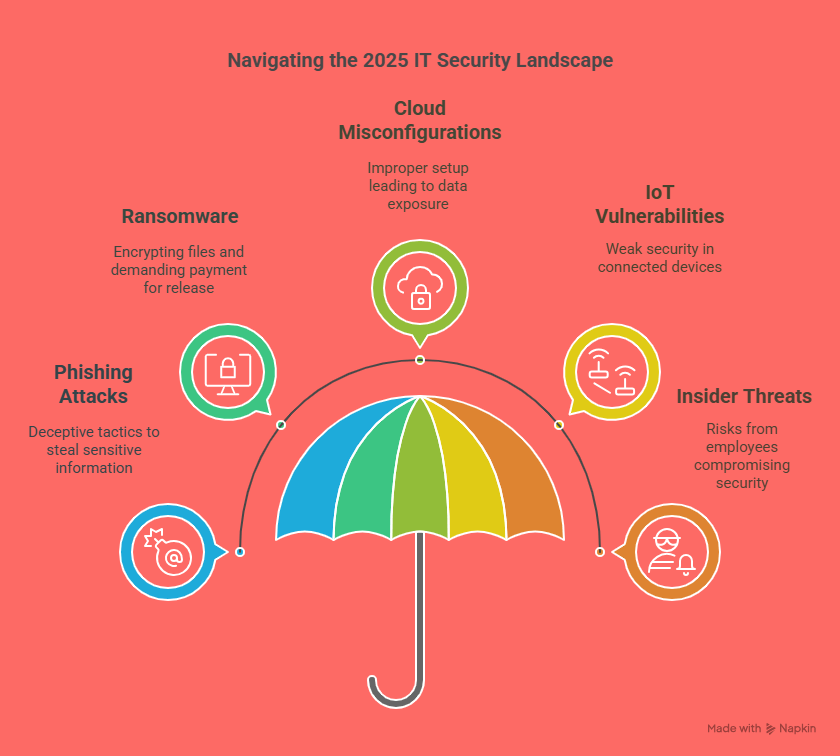
1. Phishing Attacks
Phishing attacks are a persistent and growing threat. Cybercriminals often impersonate legitimate organizations or individuals to deceive users into providing sensitive information such as login credentials or credit card details.
These attacks have evolved significantly, with attackers using advanced techniques such as spear-phishing (targeting specific individuals or companies) and voice phishing (vishing). As AI and machine learning technologies improve, attackers are able to personalize these attacks, making them harder to detect. According to a recent report, phishing attacks account for 90% of successful cyberattacks, making it crucial for organizations to implement email filtering systems, educate employees about identifying phishing emails, and adopt multi-factor authentication (MFA) to add an additional layer of defense.
2. Ransomware
Ransomware has seen a dramatic increase in both frequency and sophistication in 2025. These attacks involve encrypting a victim's files and demanding payment (often in cryptocurrency) to release the files. In some cases, attackers also threaten to publish sensitive data if the ransom is not paid.
Healthcare, finance, and public sector organizations are particularly vulnerable, as these industries rely heavily on the availability of data. Ransomware attacks not only disrupt operations but can also lead to significant financial losses, loss of consumer trust, and regulatory penalties. To protect against ransomware, organizations must implement regular data backups, maintain robust endpoint security, and train employees to avoid opening suspicious emails or links.
3. Cloud Misconfigurations
As businesses increasingly migrate to cloud environments, misconfigurations have become one of the leading causes of data breaches. These misconfigurations occur when cloud resources are improperly set up, leaving data exposed to unauthorized access.
For example, leaving a cloud storage bucket publicly accessible can allow cybercriminals to access sensitive business or customer data. Cloud security breaches can be mitigated through the adoption of secure cloud management practices, including implementing strict access controls, regular configuration audits, and real-time monitoring of cloud resources.
4. Internet of Things (IoT) Vulnerabilities
The Internet of Things (IoT) is growing exponentially, with billions of connected devices in use worldwide. These devices—ranging from smart home devices to industrial sensors—are often weak points in security systems. Many IoT devices have inadequate security protections, such as default passwords that are easy to guess. Attackers can exploit these vulnerabilities to gain access to networks or collect sensitive information.
In 2025, it is expected that cybercriminals will increasingly target IoT devices to gain unauthorized access to larger systems. To secure IoT networks, organizations should use strong encryption, regularly update firmware, and implement network segmentation to ensure that compromised devices cannot access critical systems. Professionals pursuing a Cybersecurity Certification Pathway can gain the necessary skills to address these growing IoT security challenges effectively.
5. Insider Threats
Insider threats are often overlooked but remain a major risk. These threats occur when employees or contractors intentionally or unintentionally compromise an organization’s data security. For example, an employee may accidentally click on a malicious link, or a disgruntled worker may intentionally leak confidential information.
Organizations can mitigate insider threats by implementing least-privilege access policies, monitoring user behavior, and conducting regular security training for employees. Additionally, organizations can use tools like data loss prevention (DLP) software to monitor and control data transfers within the company.
Common Types of Cyber Threats
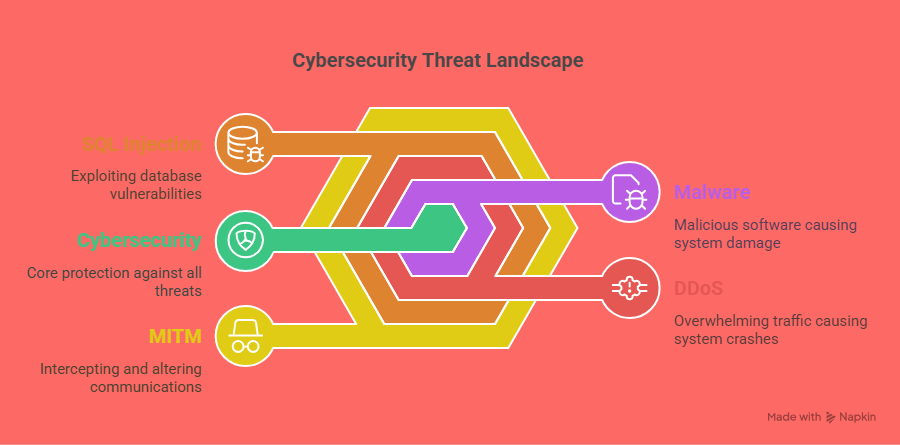
1. Malware
Malware is a category of malicious software designed to cause damage to computers and networks. Types of malware include viruses, worms, Trojans, and spyware. Malware can steal data, slow down systems, or render files inaccessible by encrypting them.
Protecting against malware involves using antivirus software, firewalls, and endpoint detection and response (EDR) tools. Additionally, regular updates and patches to software applications are critical to closing security loopholes.
2. Distributed Denial-of-Service (DDoS)
DDoS attacks overwhelm a server or network with a flood of traffic, causing it to crash and become inaccessible. These attacks are often used as a smokescreen for other types of attacks, such as data breaches.
To prevent DDoS attacks, organizations can use traffic filtering tools, employ redundant systems, and implement content delivery networks (CDNs) to distribute web traffic across multiple servers.
3. SQL Injection
SQL injection is a type of attack that targets web applications by exploiting vulnerabilities in the application's database query language. Attackers can insert malicious SQL commands into input fields, which then execute on the backend database.
To protect against SQL injection attacks, web applications must implement input validation, use prepared statements, and deploy web application firewalls (WAFs).
4. Man-in-the-Middle (MITM) Attacks
MITM attacks involve an attacker intercepting and potentially altering communication between two parties without their knowledge. These attacks often occur on unsecured networks, such as public Wi-Fi.
To secure communications, organizations should use HTTPS (SSL/TLS) to encrypt web traffic, implement VPNs for remote work, and use secure Wi-Fi protocols (WPA3). Cybersecurity Certification Reddit discussions often emphasize the importance of understanding such attack methods and the best practices to prevent them.
IT Security Solutions in 2025

1. Multi-Factor Authentication (MFA)
Multi-Factor Authentication (MFA) has become one of the most effective defenses against phishing and credential stuffing attacks. MFA requires users to provide two or more forms of identification, such as a password and a biometric scan or a one-time code sent to a mobile device.
In 2025, the adoption of MFA has become mainstream across all industries. Companies using MFA have seen a significant reduction in successful account takeover attempts. Additionally, the integration of biometric authentication (like face recognition or fingerprint scans) has made the process more seamless and secure.
2. Zero Trust Architecture
Zero Trust is a security model that assumes no one—inside or outside the organization—is trusted by default. Every access request is thoroughly verified, and users are only granted the minimum necessary access to perform their tasks.
In 2025, the Zero Trust model is gaining traction across industries as organizations move towards remote work and hybrid IT environments. Implementing Zero Trust requires strong identity management, network segmentation, and continuous monitoring.
3. Artificial Intelligence in Cybersecurity
Artificial Intelligence (AI) is increasingly being used to detect and respond to cyber threats in real-time. AI-powered tools can analyze vast amounts of data, identify patterns, and predict potential attacks before they occur.
AI's ability to detect anomalies and perform threat hunting has revolutionized cybersecurity. In 2025, AI-powered systems are becoming essential for organizations to stay ahead of cybercriminals and automate responses to security incidents.
4. Data Encryption
Data encryption is one of the most fundamental practices in IT security. Encryption converts sensitive data into unreadable code, which can only be decrypted with a specific key. It ensures that even if attackers intercept data, they cannot access it.
In 2025, encryption methods have advanced, with organizations using end-to-end encryption for communications and data storage. Quantum-resistant encryption is also being explored to protect against future quantum computing threats.
5. Employee Cybersecurity Training
Despite the availability of advanced security tools, human error remains one of the leading causes of cyber incidents. Employees may fall for phishing scams, use weak passwords, or inadvertently expose sensitive data.
In 2025, organizations are investing more in cybersecurity training, making it an essential part of onboarding and continuing education. Training programs are evolving to include simulated attacks, gamified learning, and interactive lessons—all of which can be more accessible with a Cybersecurity Certification Discount offered by select platforms and institutions.
Emerging Trends in IT Security (2025)
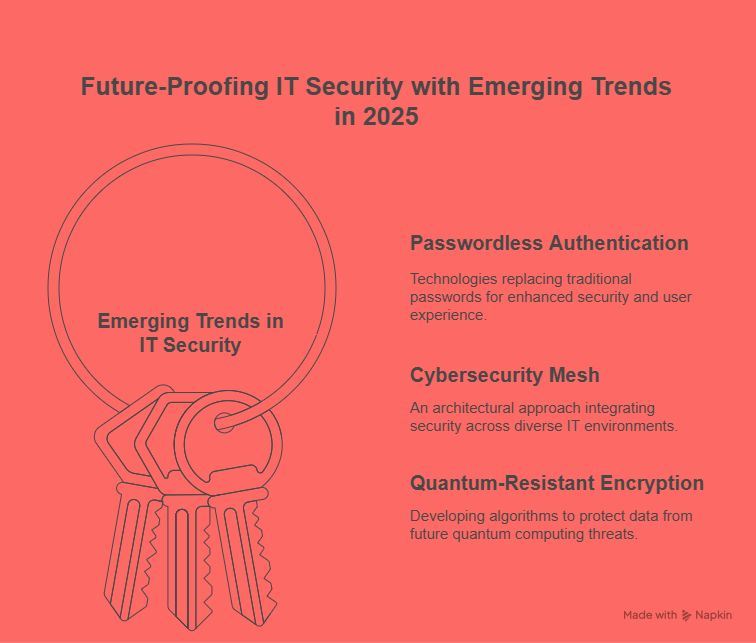
1. Passwordless Authentication
In 2025, the need for passwords is diminishing as passwordless authentication methods become more mainstream. Technologies like biometric authentication, hardware tokens, and one-time passcodes (OTPs) are replacing traditional passwords.
These solutions not only reduce the risk of credential theft but also improve user experience by eliminating the need to remember complex passwords.
2. Cybersecurity Mesh
Cybersecurity Mesh is an emerging architectural approach that connects security services to protect distributed digital assets. It allows businesses to implement security policies and controls that are integrated across all environments—cloud, on-premises, and hybrid.
By using cybersecurity mesh architecture, organizations can ensure that security policies are consistent and effective, even across complex IT infrastructures.
3. Quantum-Resistant Encryption
Quantum computing poses a serious threat to current encryption methods. In response, researchers are developing quantum-resistant encryption algorithms to protect sensitive data from future quantum attacks.
Although quantum computing is still in its infancy, organizations are already exploring ways to future-proof their encryption strategies.
Conclusion
As digital transformation continues to accelerate in 2025, the importance of robust Information Technology Security cannot be overstated. Cyber threats are becoming more sophisticated, but so are the solutions to combat them. By understanding the risks and implementing comprehensive IT security measures, businesses and individuals can safeguard their data and digital assets.
At ACSMI, we recognize the critical role security plays in every industry, including healthcare. That’s why we offer Medical Scribe Certifications that ensure professionals are equipped with the knowledge and skills to protect patient information and comply with the highest security standards. Start your career in medical scribing today with ACSMI and secure your future in healthcare documentation!
FAQs
1. What’s the difference between IT security and cybersecurity?
IT security is a broader term that includes cybersecurity. While IT security includes physical and digital protection, cybersecurity focuses purely on protecting digital systems from attacks.
2. How often should I update my security software?
Software updates should be installed immediately upon release. Delays increase exposure to vulnerabilities.
3. Is antivirus enough for complete protection in 2025?
Antivirus is essential but not enough. Businesses need firewalls, EDR, MFA, encryption, and proactive threat monitoring to stay secure.
4. What industries are most vulnerable to cyber-attacks?
Healthcare, finance, and education are among the most targeted sectors due to sensitive data and often outdated systems.
5. What’s a zero-day exploit?
It refers to a vulnerability unknown to the vendor. Attackers exploit it before the developer has time to release a fix.
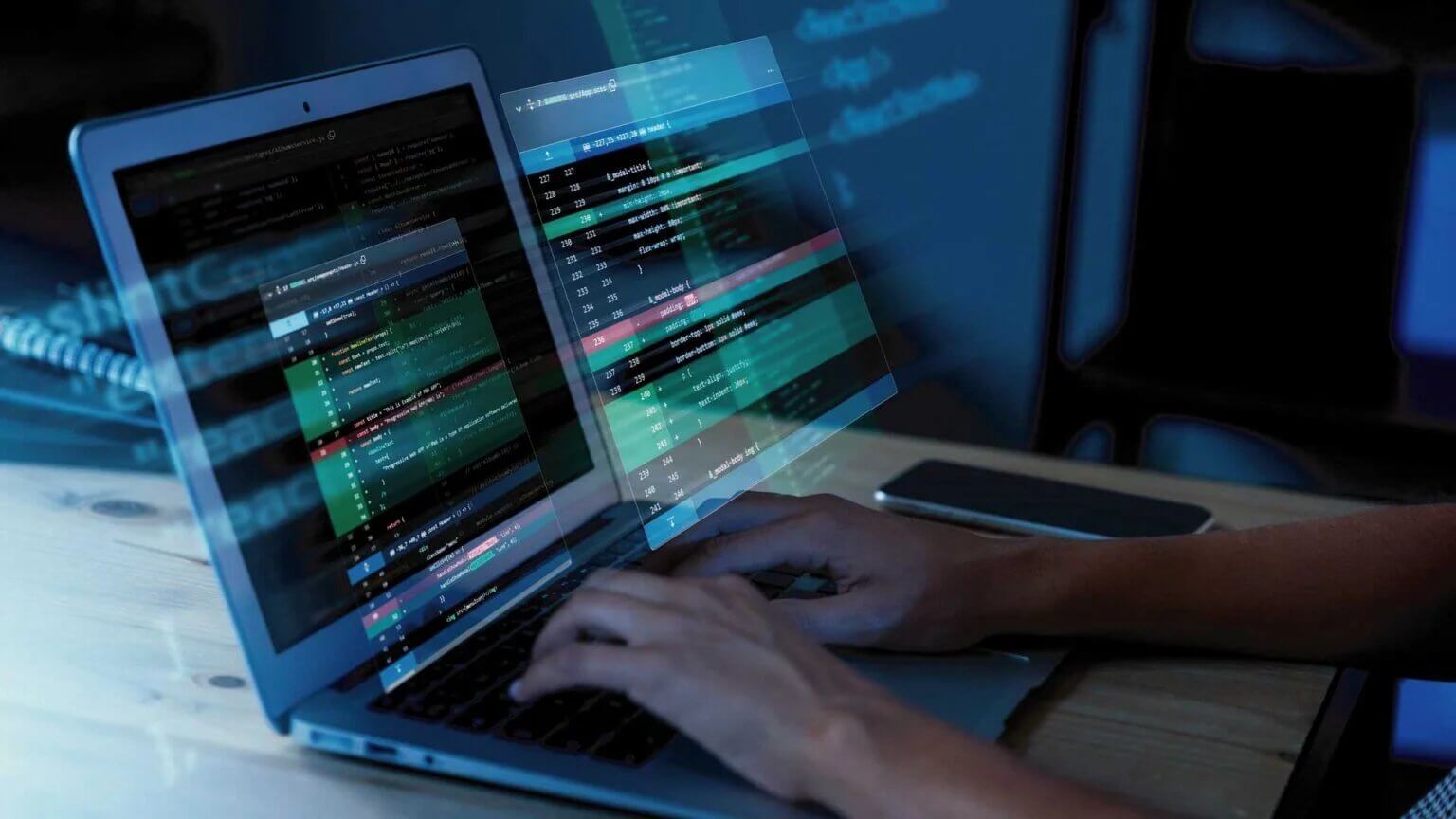
Leave a Reply